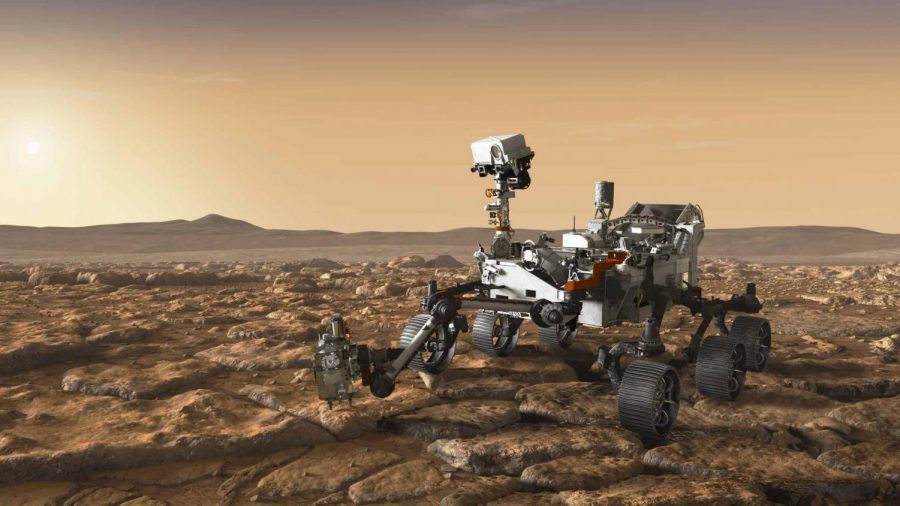Mars 2020 Perseverance Rover
April 12, 2021
On Feb. 18, 2021, NASA’s new rover named Perseverance landed in the Jezero Crater on Mars. Perseverance is part of NASA’s Mars 2020 mission which hopes to search Mars for signs of past habitability, collect samples for analysis, and test new technology that may help humans explore Mars in the future.
Perseverance had its launch on June 30, 2020, from the Cape Canaveral Air Force Station in Florida and has taken about seven months to arrive on Mars. According to NASA’s Perseverance fact sheet, the rover is about ten feet long, nine feet wide, seven feet tall, and weighs in at a staggering 2,260 pounds. It is not much larger than Curiosity, the last rover to roam the Red Planet, but is more than 270 pounds heavier.
The new rover is equipped with plenty of hardware and technology to help complete its mission on Mars. Perseverance has advanced camera systems, the ability to scan and chemically analyze its environment from a distance, ground-penetrating radars, and ways to measure things like temperature, wind speed, and humidity.
Perseverance’s main job is to “seek signs of ancient life and collect samples of rock and regolith (broken rock and soil) for possible return to Earth,” (NASA) but it will also be testing new technology for potential future use.
Perseverance will be traveling from its landing site to explore what appears to be an ancient river delta in Jezero, the reason why scientists choose the crater in the first place. It is believed that the crater was flooded with water in the distant past, and would therefore be a perfect candidate for hunting for signs of ancient microbial life.
One key technology demonstration the rover will be doing is a test of the Mars Helicopter Ingenuity. Ingenuity is a small aircraft that flew to Mars attached to the belly of Perseverance. It hopes to prove flight is possible on Mars and do so autonomously, using commands “without real-time input from Mars Helicopter mission controllers” (NASA).
The first flight test of Ingenuity is expected to occur within the next few weeks. This must occur before Perseverance will venture out to explore the dunes around the landing site and the ancient river delta located within the Jezero Crater.
Another important experimental hardware being tested by Perseverance is The Mars Oxygen In-Situ Resource Utilization Experiment (MOXIE). MOXIE can produce oxygen from the atmospheric carbon dioxide on Mars. This could potentially be used by astronauts on Mars to burn fuel for their return to Earth.
The rover has also been exploring rocks near the landing site during its first month on the Red Planet. Some appear to be weathered by the Martian winds, but others seem as though they may have been weathered by water according to Kenneth Farley, a geochemist and scientist working on the mission.
The scientists have been giving the rocks or other objects found informal names in the Navajo language. NASA’s website wrote that “Mission scientists worked with a Navajo (or Diné) engineer on the team, Aaron Yazzie of NASA’s Jet Propulsion Laboratory in Southern California, to seek the Navajo Nation’s permission and collaboration in naming new features on Mars.”
They have been given a list of words to use for names on the mission by the President of the Navajo Nation Jonathan Nez who stated “The partnership that the Nez-Lizer Administration has built with NASA will help to revitalize our Navajo language… We hope that having our language used in the Perseverance mission will inspire more of our young Navajo people to understand the importance and the significance of learning our language. Our words were used to help win World War II, and now we are helping to navigate and learn more about the planet Mars.”
Perseverance is also tasked with taking many photos using Mastcam-Z which can take panoramic and stereoscopic photos. The rover has already taken over 10,000 images in its month or so on Mars. These photos can all be viewed on NASA’s website.

